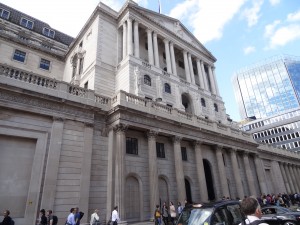 An economy that becomes dependent on credit can, in turn, become acutely volatile. Too much credit and there exists the potential for financial distress which can result in an economic slowdown as people cut back on spending. Too little credit and the growth in aggregate demand is subdued. Some argue that this is what now faces a financialised economy like the UK. Even it this overstates the significance of credit, there is no doubt that UK credit data is keenly followed by economists and policymakers.
An economy that becomes dependent on credit can, in turn, become acutely volatile. Too much credit and there exists the potential for financial distress which can result in an economic slowdown as people cut back on spending. Too little credit and the growth in aggregate demand is subdued. Some argue that this is what now faces a financialised economy like the UK. Even it this overstates the significance of credit, there is no doubt that UK credit data is keenly followed by economists and policymakers.
Recent rates of credit accumulation by individuals have raised concern. In July 2014 the Prudential Regulation Authority (PRA) of the Bank of England issued a statement voicing its concern that the growth in consumer credit, also known as unsecured lending, was stretching the financial well-being of individuals and that the resilience of lenders’ consumer credit portfolios was therefore reducing.
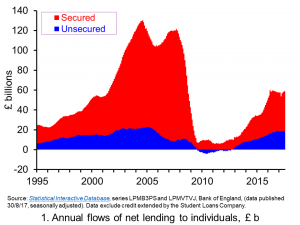 Chart 1 illustrates the scale of the flows of both consumer credit (unsecured lending) and mortgages (secured credit) from banks and building societies to individuals. It shows the amount of credit net of repayments lent over the last 12 months. In the 12 months to July 2017 the net accumulation of consumer credit was £18.2 billion while that of secured borrowing was £40.8 billion. Although the 12-month level of consumer credit accumulation was down from its recent peak of £19.2 billion in November 2016, total net lending (including secured lending) to individuals of £59.0 billion was its highest since September 2008. (Click here to download a PowerPoint of the chart).
Chart 1 illustrates the scale of the flows of both consumer credit (unsecured lending) and mortgages (secured credit) from banks and building societies to individuals. It shows the amount of credit net of repayments lent over the last 12 months. In the 12 months to July 2017 the net accumulation of consumer credit was £18.2 billion while that of secured borrowing was £40.8 billion. Although the 12-month level of consumer credit accumulation was down from its recent peak of £19.2 billion in November 2016, total net lending (including secured lending) to individuals of £59.0 billion was its highest since September 2008. (Click here to download a PowerPoint of the chart).
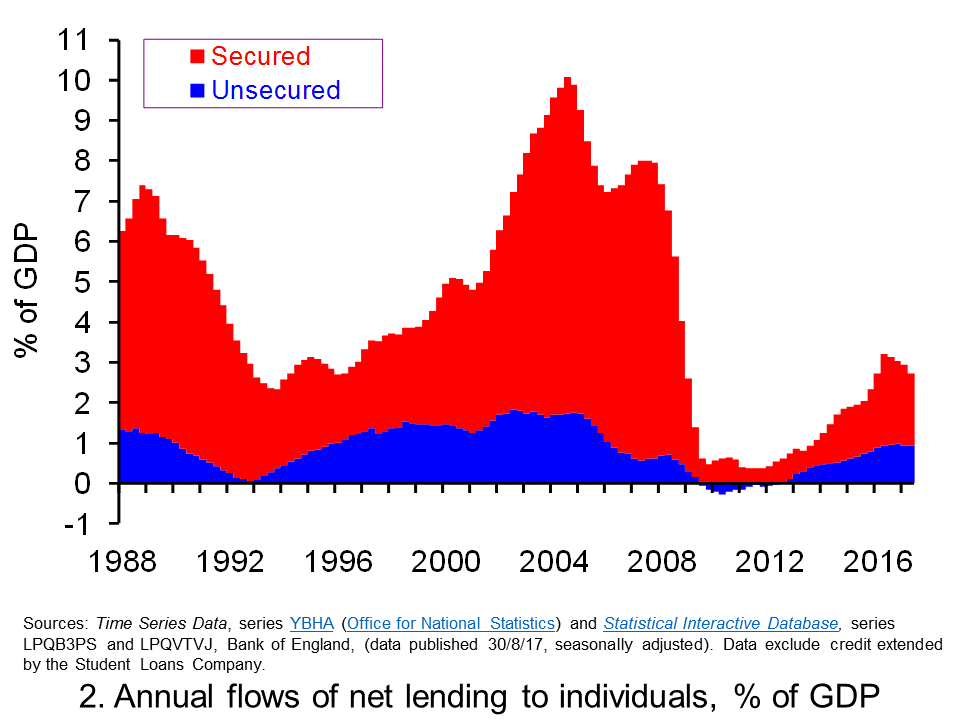 To help put in context the size of flows of net lending Chart 2 shows the annual flows of consumer credit and secured debt as percentages of GDP. In this case each observation measures net lending over the past four quarters as a percentage of annual GDP. The latest observation is for 2017 Q2 and shows that the annual net flow of consumer credit was equivalent to 0.94 per cent of GDP while that for secured borrowing was 1.78 per cent of GDP. While the flows of consumer credit and secured borrowing as shares of national income have eased a little from their values in the second half of last year, they have not eased significantly. (Click here to download a PowerPoint of the chart).
To help put in context the size of flows of net lending Chart 2 shows the annual flows of consumer credit and secured debt as percentages of GDP. In this case each observation measures net lending over the past four quarters as a percentage of annual GDP. The latest observation is for 2017 Q2 and shows that the annual net flow of consumer credit was equivalent to 0.94 per cent of GDP while that for secured borrowing was 1.78 per cent of GDP. While the flows of consumer credit and secured borrowing as shares of national income have eased a little from their values in the second half of last year, they have not eased significantly. (Click here to download a PowerPoint of the chart).
 Despite the recent strength of borrowing, levels are nothing like those seen in the mid 2000s. Nonetheless, we need to see the current accumulation of debt in the context of two important factors: debt already accumulated and the future macroeconomic environment. Chart 3 gives some insight to the first of these two by looking at stocks of debt outstanding as shares of GDP. The total debt-to-GDP ratio peaked 90 percent in 2009 before relatively slower growth in credit accumulation saw the ratio fall back. The ratio has now been at or around the 78 per cent level consistently for the past two or so years. (Click here to download a PowerPoint of the chart).
Despite the recent strength of borrowing, levels are nothing like those seen in the mid 2000s. Nonetheless, we need to see the current accumulation of debt in the context of two important factors: debt already accumulated and the future macroeconomic environment. Chart 3 gives some insight to the first of these two by looking at stocks of debt outstanding as shares of GDP. The total debt-to-GDP ratio peaked 90 percent in 2009 before relatively slower growth in credit accumulation saw the ratio fall back. The ratio has now been at or around the 78 per cent level consistently for the past two or so years. (Click here to download a PowerPoint of the chart).
The ratio of the stock of consumer debt to GDP peaked in 2008 at 13.3 per cent. It too fell back reaching 9.05 per cent in the middle of 2014. Since that time the ratio has been rising and by the end of the second quarter of this year was 10.1 per cent. The PRA appears not only to be concerned by this but also the likely unwinding of what it describes as the ‘current benign macroeconomic environment and historically low arrears rates’.
Going forward, we might expect to see ever closer scrutiny not only of the aggregate indicators referred to here but of an array of credit indicators. The PRA statement, for example, refers to the number of , ‘0% interest credit card offers’, falling interest rates on unsecured personal loans and the growth of motor finance loans. The hope is that we can avoid the costs of financial distress that so starkly affected the economy in the late 2000s and that continue to cast a shadow over today’s economic prospects.
PRA Statement
PRA Statement on Consumer Credit PRA, Bank of England (4/7/14)
Articles
Bank of England demands consumer credit vigilance; construction growth slows – as it happened Guardian (4/7/14)
Bank of England warns more defences may be needed against consumer credit Telegraph (24/7/17)
Beware the bubble: Bank of England clamps down on credit Telegraph, Tim Wallace (1/7/17)
Bank of England raises capital requirements on UK lenders amid concerns about excessive consumer borrowing Independent, Ben Chu (27/6/17)
Bank of England tightens mortgage borrowing rules amid fears of debt boom Express, Lana Clements (27/6/17)
Rise in personal loans dangerous, Bank of England official says BBC News (25/7/17)
Bank of England takes action over bad loans BBC News (27/6/17)
Data
Bankstats (Monetary and Financial Statistics) – Latest Tables Bank of England
Statistical Interactive Database Bank of England
Questions
- What does it mean if people are financially distressed? What responses might people take in response to this distress?
- How can financial distress affect the economy’s growth path?
- How would you measure the financial well-being of an individual? What about the financial well-being of firms?
- What role mights banks play in affecting levels of financial distress in the economy?
- What does it mean if credit conditions are pro-cyclical?
- Why might banks’ lending be pro-cyclical?
- Are there measures that policymakers can take to reduce the likelihood that flows of credit become too excessive?
- Why do some economists refer to the economic downturn of the late 2000s as a balance sheet recession? How likely is another balance sheet recession in the short term? What about in the longer term?
 According to a new report, Time for Change published by the Institute for Public Policy Research (IPPR), ‘The British economic model needs fundamental reform.’
According to a new report, Time for Change published by the Institute for Public Policy Research (IPPR), ‘The British economic model needs fundamental reform.’
It is no longer generating rising earnings for a majority of the population, and young people today are set to be poorer than their parents. Beneath its headlines figures, the economy is suffering from deep and longstanding weaknesses, which make it unfit to face the challenges of the 2020s.
The report by the IPPR’s Commission on Economic Justice is an interim one, with the final report due in the latter part of next year. The commission was set up in 2016 and includes business leaders, such as the heads of John Lewis and Siemens, the TUC General Secretary, the Archbishop of Canterbury and other leading figures.
Commenting on the interim report, Justin Welby, the Archbishop of Canterbury said
Our economic model is broken. Britain stands at a watershed moment where we need to make fundamental choices about the sort of economy we need. We are failing those who will grow up into a world where the gap between the richest and poorest parts of the country is significant and destabilising
The report found that wages have stagnated for the majority of the population since the financial crisis of 2007/8. Wage income has fallen as a proportion of national income, while the proportions going to income from profits and property have risen. Young people are poorer than previous generations of young people.
Despite low unemployment, many people are on zero-hour contracts, part-time contracts or employed on a casual basis. For many, their jobs are insecure and they have no bargaining power.
 The UK for many years has had a lower rate of investment that other developed economies and productivity, in terms of output per hour, is the lowest of its major competitors. Productivity in Germany is 36% higher than in the UK; in France and the USA it is 29% higher. Although there are some internationally competitive UK firms with high productivity, the country has:
The UK for many years has had a lower rate of investment that other developed economies and productivity, in terms of output per hour, is the lowest of its major competitors. Productivity in Germany is 36% higher than in the UK; in France and the USA it is 29% higher. Although there are some internationally competitive UK firms with high productivity, the country has:
a longer ‘tail’ of low-productivity businesses, in which weak management and poor use of skills leads to ‘bad jobs’ and low wages.
There are many other challenges, including an ageing population, uncertainties from Brexit, a large current account deficit, increased competition from abroad and growth once more in private-sector debt, which means that consumption may cease to be the main driver of economic growth as people seek to curb their borrowing.
The report is also critical of fiscal policy, which with record low interest rates could have been used to finance infrastructure projects as well as supporting public services.
The report recommends three approaches:
The first is institutional reform to support investment.
The second is making the economy more competitive through a coherent industrial strategy, reform of the financial sector to support long-term investment, reform of corporate governance to promote business success and tackling the market dominance of companies such as Amazon and Google.
The third is to bring greater social justice and equality through encouraging more secure and better-paid jobs, strengthening trades unions and reforming the tax system to make it fairer and smarter.
Not surprisingly the government has defended its record of reducing debt, presiding over falling unemployment and reduced inequality as measured by a reduced Gini coefficient. However, there has only been a modest fall in the Gini coefficient, from 0.333 in 2009/10 to 0.315 in 2016/7, and this has largely been the result of the very rich seeing a decline in income from assets.
Articles
Britain’s economy is broken and failing to tackle inequality, says major new report Independent, Ben Chu (6/9/17)
UK’s economic model is broken, says Archbishop of Canterbury The Guardian, Phillip Inman (5/9/17)
Tax wealth or see the UK tear itself apart, Cable will warn Bloomberg, Alex Morales and Thomas Penny (6/9/17)
Archbishop of Canterbury calls for radical economic reform BBC News (5/9/17)
Archbishop warns economy is “broken” as report reveals longest period of wage stagnation for 150 years Huffington Post, Rachel Wearmouth (6/9/17)
Britain’s economy is broken. We desperately need new ideas The Guardian, Tom Kibasi (4/6/17)
Carney: Britain is in the ‘first lost decade since the 1860s’, Business Insider, Oscar Williams-Grut (6/12/16)
Our broken economy, in one simple chart New York Times, David Leonhardt (7/8/16)
Report
Time for Change: A new Vision for the British Economy IPPR Commission on Economic Justice (6/9/17)
Questions
- Why have wages for the majority of the UK population stagnated for the past 10 years?
- Why is productivity in the UK lower than in most other developed economies?
- Is it possible for poor people to become poorer and yet for the Gini coefficient to fall?
- What institutional reforms would you suggest to encourage greater investment?
- Explain the possible advantages and disadvantages of abandoning ‘austerity policy’ and adopting a more expansionist fiscal stance?
- Does it matter that Amazon and Google are dominant players in their respective markets? Explain.
 Ten years ago (on 9 August 2007), the French bank BNP Paribas sparked international concern when it admitted that it didn’t know what many of its investments in the US sub-prime property market were worth and froze three of its hedge funds. This kicked off the financial crisis and the beginning of the credit crunch.
Ten years ago (on 9 August 2007), the French bank BNP Paribas sparked international concern when it admitted that it didn’t know what many of its investments in the US sub-prime property market were worth and froze three of its hedge funds. This kicked off the financial crisis and the beginning of the credit crunch.
In September 2007 there was a run on the Northern Rock bank in the UK, forcing the Bank of England to provide emergency funding. Northern Rock was eventually nationalised in February 2008. In July 2008, the US financial authorities had to provide emergency assistance to America’s two largest mortgage lenders, Fannie Mae and Freddie Mac.
Then in September 2008, the financial crisis really took hold. The US bank, Lehman Brothers, filed for bankruptcy, sending shock waves around the global economy. In the UK, Lloyds TSB announced that it was taking over the UK’s largest mortgage lender, Halifax Bank Of Scotland (HBOS), after a run on HBOS shares.
Later in the month, Fortis, the huge Belgian banking, finance and insurance company, was partly nationalised to prevent its bankruptcy. Also the UK government was forced to take control of mortgage-lender, Bradford & Bingley’s, mortgages and loans, with the rest of the business sold to Santander.
Early in October 2008, trading was suspended in the main Icelandic banks. Later in the month, the UK government announced a £37 billion rescue package for Royal Bank of Scotland (RBS), Lloyds TSB and HBOS. Then in November it partially nationalised RBS by taking a 58% share in the bank. Meanwhile various other rescue packages and emergency loans to the banking sector were taking place in other parts of the world. See here for a timeline of the financial crisis.

So, ten years on from the start of the crisis, have the lessons of the crisis been learnt. Could a similar crisis occur again?
The following articles look at this question and the answers are mixed.
On the positive side, banks are much more highly capitalised than they were ten years ago. Moves by the Basel Committee on Banking Supervision in its Basel III regulatory framework have ensured that banks are much more highly capitalised and operate with higher levels of liquidity. What is more, banks are generally more cautious about investing in highly complex and risky collateralised assets.
On the negative side, increased flexibility in labour markets, although helping to keep unemployment down, has allowed a huge squeeze on real wages as austerity measures have dampened the economy. What is more, household debt is rising to possibly unsustainable levels. Over the past year, unsecured debt (e.g. personal loans and credit card debt) have risen by 10% and yet (nominal) household incomes have risen by only 1.5%. While record low interest rates make such loans relatively affordable, when interest rates do eventually start to rise, this could put a huge strain on household finances. But if households start to rein in their borrowing, this would put downward pressure on aggregate demand and jeopardise economic growth.
Articles
- The crisis: 10 years in three chart
BBC News, Simon Jack (9/8/17)
 Darling: ‘Alarm bells ringing’ for UK economy
Darling: ‘Alarm bells ringing’ for UK economyBBC News (9/8/17)
- Alistair Darling warns against ‘complacency’ 10 years on from financial crisis
The Telegraph (9/8/17)
- A decade after the financial crisis consumers are still worried
Independent, Kate Hughes (9/8/17)
- Bankers still do not understand complex reasons behind financial crash, senior politician warns
Independent, Ashley Cowburn (9/8/17)
- We let the 2007 financial crisis go to waste
The Guardian, Torsten Bell (9/8/17)
- Bank of England warns of complacency over big rise in personal debt
The Guardian, Larry Elliott (24/7/17)
- On the 10th anniversary of the global financial meltdown, here’s what’s changed
USA Today, Kim Hjelmgaard (8/8/17)
- Financial crisis: Ten years ago today the tremors started
Irish Times (9/8/17)
 If We Are Racing to the Pre-Crisis Bubble, Here Are 12 Charts To Watch
If We Are Racing to the Pre-Crisis Bubble, Here Are 12 Charts To WatchBloomberg, Sid Verma (9/8/17)
Videos
Questions
- Explain what are meant by ‘collateralised debt obligations (CDOs)’.
- What part did CDOs play in the financial crisis of 2007–8?
- In what ways is the current financial situation similar to that in 2007–8?
- In what ways is it different?
- Explain the Basel III banking regulations.
- To what extent has the Bank of England exceeded the minimum Basel III requirements?
- Explain what is meant by ‘stress testing’ the banks? Does this ensure that there can never be a repeat of the financial crisis?
- Why is it desirable for central banks eventually to raise interest rates to a level of around 2–3%? Why might it be difficult for central banks to do that?
 In the last blog post, As UK inflation rises, so real wages begin to fall, we showed how the rise in inflation following the Brexit vote is causing real wages in the UK to fall once more, after a few months of modest rises, which were largely due to very low price inflation. But how does this compare with other OECD countries?
In the last blog post, As UK inflation rises, so real wages begin to fall, we showed how the rise in inflation following the Brexit vote is causing real wages in the UK to fall once more, after a few months of modest rises, which were largely due to very low price inflation. But how does this compare with other OECD countries?
In an article by Rui Costa and Stephen Machin from the LSE, the authors show how, from the start of the financial crisis in 2007 to 2015 (the latest year for which figures are available), real hourly wages fell further in the UK than in all the other 27 OECD countries, except Greece (see the chart below, which is Figure 5 from their article). 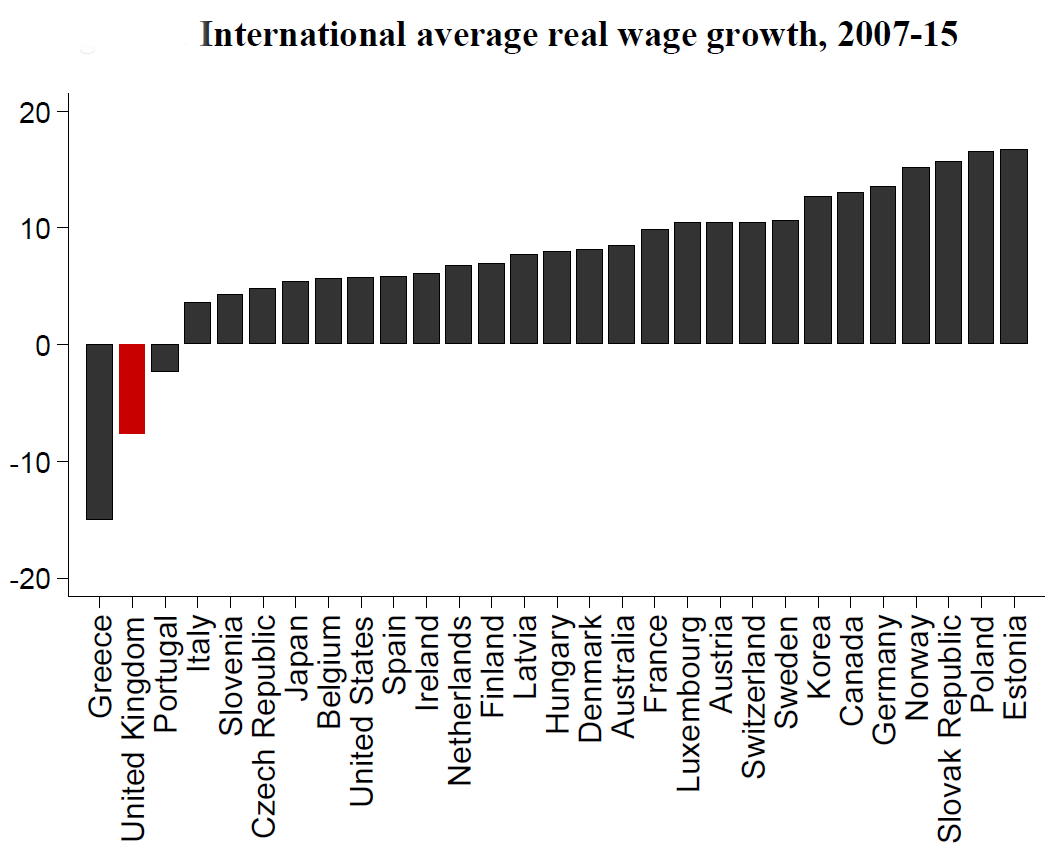 Indeed, only in Greece, the UK and Portugal were real wages lower in 2015 than in 2007.
Indeed, only in Greece, the UK and Portugal were real wages lower in 2015 than in 2007.
The authors examine a number of aspects of real wages in the UK, including the rise in self employment, differences by age and sex, and for different percentiles in the income distribution. They also look at how family incomes have suffered less than real wages, thanks to the tax and benefit system.
The authors also look at what the different political parties have been saying about the issues during their election campaigns and what they plan to do to address the problem of falling, or only slowly rising, real wages.
Articles
Real Wages and Living Standards in the UK LSE – Centre for Economic Performance, Rui Costa and Stephen Machin (May 2017)
The Return of Falling Real Wages LSE – Centre for Economic Performance, David Blanchflower, Rui Costa and Stephen Machin (May 2017)
The chart that shows UK workers have had the worst wage performance in the OECD except Greece Independent, Ben Chu (5/6/17)
Data
Earnings and working hours ONS
OECD.Stat OECD
International comparisons of productivity ONS
Questions
- Why have real wages fallen more in the UK than in all OECD countries except Greece?
- Which groups have seen the biggest fall in real wages? Explain why.
- What policies are proposed by the different parties for raising real wages (a) generally; (b) for the poorest workers?
- How has UK productivity growth compared with that in other developed countries? What explanations can you offer?
- What is the relationship between productivity growth and the growth in real wages?
 With the effects of the depreciation of sterling feeding through into higher prices, so the rate of inflation has risen. The latest figures from the ONS show that in the year to April 2017, CPI inflation was 2.7% – up from 2.3% in the year to March. The largest contributors to higher prices were transport costs and housing and household services.
With the effects of the depreciation of sterling feeding through into higher prices, so the rate of inflation has risen. The latest figures from the ONS show that in the year to April 2017, CPI inflation was 2.7% – up from 2.3% in the year to March. The largest contributors to higher prices were transport costs and housing and household services.
But wage increases are not keeping up with price increases. In 2017 Q1, the average annual growth rate in regular pay (i.e. excluding bonuses) was 2.1%. In other words, real pay is falling. And this is despite the fact that the unemployment rate, at 4.6%, is the lowest since 1975.
The fall in real wages is likely to act as a brake on consumption and the resulting dampening of aggregate demand could result in lower economic growth. On the other hand, the more buoyant world economy, plus the lower sterling exchange rate is helping to boost exports and investment and this could go some way to offsetting the effects on consumption. As Mark Carney stated in his introductory remarks to the May 2017 Bank of England Inflation Report:
The combination of the stronger global outlook and sterling’s past depreciation is likely to support UK net trade. And together with somewhat lower uncertainty, stronger global growth is also likely to encourage investment as exporters renew and increase capacity.
According to the Bank of England, the net effect will be modest economic growth, despite the fall in real wages.
In the MPC’s central forecast, quarterly growth is forecast to stabilise around its current rate, resulting in growth of 1.9% in 2017 and around 1¾% in each of the next two years.
 But forecasting is dependent on a range of assumptions, not least of which are assumptions about consumer and business expectations. These, in turn, depend on a whole range of factors, such as the outcome of the UK election, the Brexit negotiations, commodity prices, world growth rates and international events, such as the actions of Donald Trump. Because of the uncertainty surrounding forecasts, the Bank of England uses fan charts. In the two fan charts illustrated below (from the May 2017 Inflation Report), the bands on constructed on the following assumptions:
But forecasting is dependent on a range of assumptions, not least of which are assumptions about consumer and business expectations. These, in turn, depend on a whole range of factors, such as the outcome of the UK election, the Brexit negotiations, commodity prices, world growth rates and international events, such as the actions of Donald Trump. Because of the uncertainty surrounding forecasts, the Bank of England uses fan charts. In the two fan charts illustrated below (from the May 2017 Inflation Report), the bands on constructed on the following assumptions:
If economic circumstances identical to today’s were to prevail on 100 occasions, the MPC’s best collective judgement is that CPI inflation or the mature estimate of GDP growth would lie within the darkest central band on only 30 of those occasions and within each pair of the lighter coloured areas on 30 occasions.
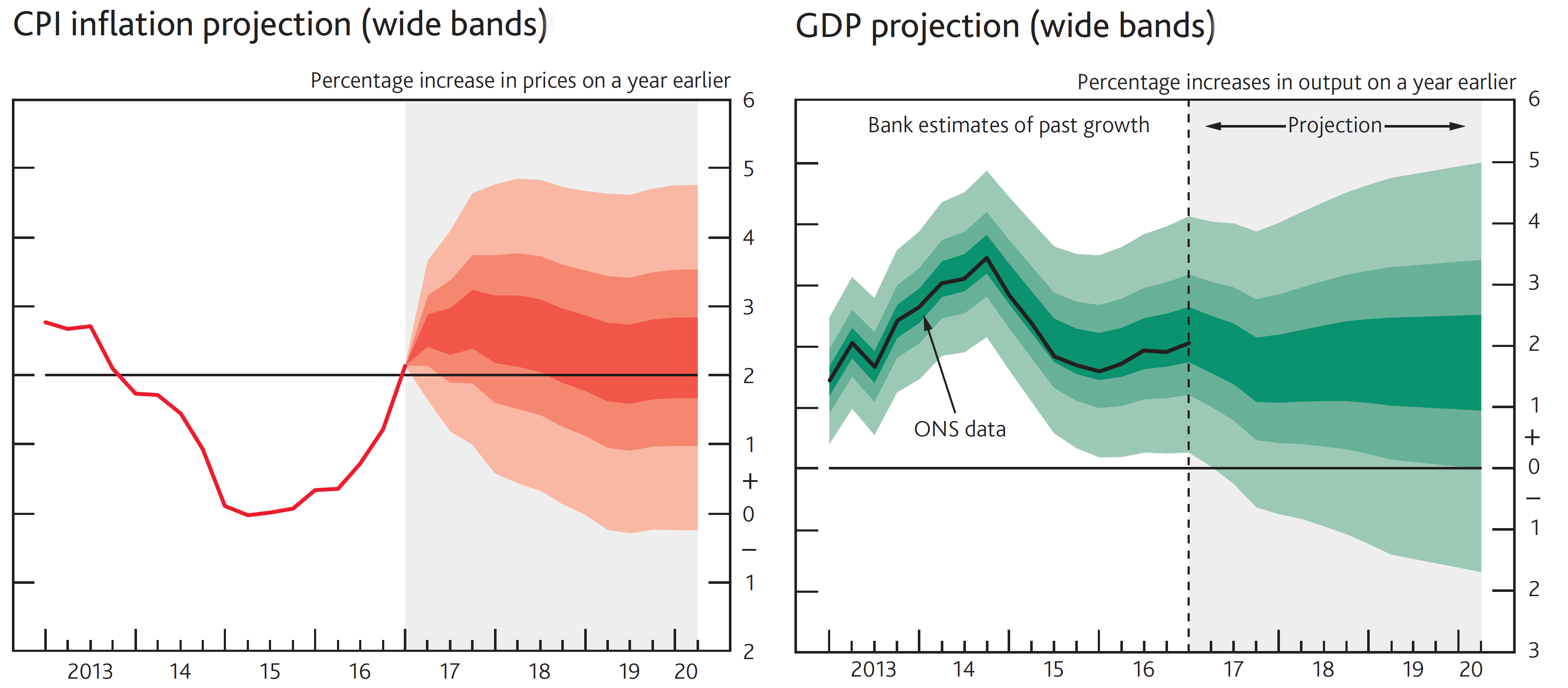
The charts and tables showing the May 2017 projections have been conditioned on the assumptions that the stock of purchased gilts remains at £435 billion and the stock of purchased corporate bonds remains at £10 billion throughout the forecast period, and on the Term Funding Scheme (TFS); all three of which are financed by the issuance of central bank reserves. They have also been conditioned on market interest rates, unless otherwise stated.
The wider the fan, the greater the degree of uncertainty. These fan charts are wide by historical standards, reflecting the particularly uncertain future for the UK economy.
But one thing is clear from the latest data: real incomes are falling. This is likely to dampen consumer spending, but just how much this will impact on aggregate demand over the coming months remains to be seen.
Articles
UK real wages drop for first time in three years Financial Times, Sarah O’Connor (17/5/17)
Bank of England warns Brexit vote will damage living standards The Guardian, Katie Allen (11/5/17)
UK wage growth lags inflation for first time since mid-2014 BBC News (17/5/17)
Britons’ Falling Real Wages Show Challenging Times Have Arrived Bloomberg, Scott Hamilton and Lucy Meakin (17/5/17)
Jobs market will suffer a Brexit slowdown, say experts The Guardian, Angela Monaghan and Phillip Inman (15/5/17)
Pay will continue to be squeezed, employers’ survey suggests BBC News, Kamal Ahmed (15/5/17)
Brexit latest: Real wages falling, Office for National Statistics reveals Independent, Ben Chu (17/5/17)
UK inflation climbs to four-year high, beating forecasts Financial Times, Gavin Jackson (16/5/17)
Why is UK inflation at a four-year high? Financial Times, Gavin Jackson (19/5/17)
A blip, or a test of hawks’ patience? Economists respond to high UK inflation data Financial Times, Nicholas Megaw (16/5/17)
UK inflation rate at highest level since September 2013 BBC News (16/5/17)
Inflation jumps to its highest level since 2013 as Brexit continues to bite Business Insider, Will Martin (16/5/17)
UK GDP growth weaker than expected as inflation hits spending The Guardian, Katie Allen (25/5/17)
UK economic growth estimate revised down BBC News (25/5/17)
Reports
Inflation Report, May 2017 Bank of England (11/5/17)
Labour Market Outlook, Sping 2017 Chartered Institute of Personnel and Development (May 2017)
Data
Statistical Interactive Database – interest & exchange rates data Bank of England
Inflation and price indices ONS
Earnings and working hours ONS
Second estimate of GDP: Jan to Mar 2017 ONS Statistical Bulletin (25/5/17)
Questions
- Find out what has happened to the dollar/sterling and the euro/sterling exchange rate and the sterling exchange rate index over the past 24 months. Plot the data on a graph.
- Explain the changes in these exchange rates.
- Why is there negative real wage growth in the UK when the rate of unemployment is the lowest it’s been for more than 40 years?
- Find out what proportion of aggregate demand is accounted for by household consumption. Why is this significant in understanding the likely drivers of economic growth over the coming months?
- Why is uncertainty over future UK growth rates relatively high at present?
- Why is inflation likely to peak later this year and then fall?
- What determines the size and shape of the fan in a fan chart?
 An economy that becomes dependent on credit can, in turn, become acutely volatile. Too much credit and there exists the potential for financial distress which can result in an economic slowdown as people cut back on spending. Too little credit and the growth in aggregate demand is subdued. Some argue that this is what now faces a financialised economy like the UK. Even it this overstates the significance of credit, there is no doubt that UK credit data is keenly followed by economists and policymakers.
An economy that becomes dependent on credit can, in turn, become acutely volatile. Too much credit and there exists the potential for financial distress which can result in an economic slowdown as people cut back on spending. Too little credit and the growth in aggregate demand is subdued. Some argue that this is what now faces a financialised economy like the UK. Even it this overstates the significance of credit, there is no doubt that UK credit data is keenly followed by economists and policymakers. Chart 1 illustrates the scale of the flows of both consumer credit (unsecured lending) and mortgages (secured credit) from banks and building societies to individuals. It shows the amount of credit net of repayments lent over the last 12 months. In the 12 months to July 2017 the net accumulation of consumer credit was £18.2 billion while that of secured borrowing was £40.8 billion. Although the 12-month level of consumer credit accumulation was down from its recent peak of £19.2 billion in November 2016, total net lending (including secured lending) to individuals of £59.0 billion was its highest since September 2008. (Click here to download a PowerPoint of the chart).
Chart 1 illustrates the scale of the flows of both consumer credit (unsecured lending) and mortgages (secured credit) from banks and building societies to individuals. It shows the amount of credit net of repayments lent over the last 12 months. In the 12 months to July 2017 the net accumulation of consumer credit was £18.2 billion while that of secured borrowing was £40.8 billion. Although the 12-month level of consumer credit accumulation was down from its recent peak of £19.2 billion in November 2016, total net lending (including secured lending) to individuals of £59.0 billion was its highest since September 2008. (Click here to download a PowerPoint of the chart). To help put in context the size of flows of net lending Chart 2 shows the annual flows of consumer credit and secured debt as percentages of GDP. In this case each observation measures net lending over the past four quarters as a percentage of annual GDP. The latest observation is for 2017 Q2 and shows that the annual net flow of consumer credit was equivalent to 0.94 per cent of GDP while that for secured borrowing was 1.78 per cent of GDP. While the flows of consumer credit and secured borrowing as shares of national income have eased a little from their values in the second half of last year, they have not eased significantly. (Click here to download a PowerPoint of the chart).
To help put in context the size of flows of net lending Chart 2 shows the annual flows of consumer credit and secured debt as percentages of GDP. In this case each observation measures net lending over the past four quarters as a percentage of annual GDP. The latest observation is for 2017 Q2 and shows that the annual net flow of consumer credit was equivalent to 0.94 per cent of GDP while that for secured borrowing was 1.78 per cent of GDP. While the flows of consumer credit and secured borrowing as shares of national income have eased a little from their values in the second half of last year, they have not eased significantly. (Click here to download a PowerPoint of the chart).  Despite the recent strength of borrowing, levels are nothing like those seen in the mid 2000s. Nonetheless, we need to see the current accumulation of debt in the context of two important factors: debt already accumulated and the future macroeconomic environment. Chart 3 gives some insight to the first of these two by looking at stocks of debt outstanding as shares of GDP. The total debt-to-GDP ratio peaked 90 percent in 2009 before relatively slower growth in credit accumulation saw the ratio fall back. The ratio has now been at or around the 78 per cent level consistently for the past two or so years. (Click here to download a PowerPoint of the chart).
Despite the recent strength of borrowing, levels are nothing like those seen in the mid 2000s. Nonetheless, we need to see the current accumulation of debt in the context of two important factors: debt already accumulated and the future macroeconomic environment. Chart 3 gives some insight to the first of these two by looking at stocks of debt outstanding as shares of GDP. The total debt-to-GDP ratio peaked 90 percent in 2009 before relatively slower growth in credit accumulation saw the ratio fall back. The ratio has now been at or around the 78 per cent level consistently for the past two or so years. (Click here to download a PowerPoint of the chart).








